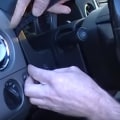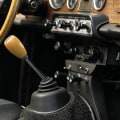Are you restoring a classic Triumph TR? Taking on this project can be daunting, but with the right knowledge and tools, it can be a rewarding experience. One key aspect of the restoration process is the suspension system: repair and upgrades can make a huge difference in the performance of your vehicle. In this article, we'll explore the importance of suspension repair and upgrades for Triumph TR restoration and provide essential tips for getting the job done. The Triumph TR is an iconic classic car that has long been associated with performance. When undertaking a restoration of a Triumph TR, it is important to pay special attention to the suspension.
This article will provide you with an overview of the tools and techniques required for suspension repair and upgrades on your Triumph TR. The first thing to consider when repairing or upgrading the suspension on a Triumph TR is the parts. There are several different types of suspension parts available for this classic car, including shock absorbers, springs, and control arms. Shock absorbers are responsible for dampening the movement of the wheels and providing a smoother ride. Springs are responsible for providing the necessary support and resistance to maintain the desired ride height and handling characteristics.
Finally, control arms are responsible for controlling the movement of the wheels and providing additional stability. In order to successfully repair or upgrade the suspension of a Triumph TR, you will need the right tools and techniques. A good set of tools is essential for any suspension repair or upgrade. These tools include torque wrenches, spring compressors, pry bars, and other specialized tools. Additionally, it is important to have an understanding of basic suspension techniques such as spring installation, shock absorber installation, and alignment. Once you have the right tools and knowledge, installing the suspension parts can be relatively straightforward.
The first step in installation is to remove the existing suspension components. This involves disconnecting the shocks and springs from the control arms, removing the nuts and bolts holding them in place, and then removing them from the car. Once these components are removed, new parts can be installed. Depending on the type of part being installed, some drilling or welding may be required in order to properly attach it. Although installing suspension parts can generally be done without too much difficulty, there are times when problems can arise.
Troubleshooting issues with your suspension can be a tricky process. It is important to understand the cause of any problem before attempting to fix it. Common issues include loose or worn components, improper alignment, and improperly installed parts. If any of these issues arise, it is important to consult a professional mechanic. Repairing or upgrading the suspension of a Triumph TR provides many benefits.
Installing new components can improve overall performance and handling while also increasing safety. Additionally, replacing old worn out parts can help improve ride comfort and extend the life of your car. Overall, making sure your Triumph TR’s suspension is in good condition can help ensure that you get the most out of your classic car.
Tools and Techniques
When restoring a Triumph TR, it is important to have the right tools for suspension repair and upgrades. Common tools needed include a socket wrench set, hammer, screwdriver set, ratchet set, adjustable pliers, and various wrenches.It is also important to have a good jack and jack stands to properly raise and support the vehicle. To install new suspension parts, it is important to understand the different techniques. Installing springs requires using a spring compressor. Installing shocks requires using a torque wrench to ensure the correct torque settings are achieved. Installing control arms and other components requires using a press or hydraulic press.
Understanding how to use these tools correctly is critical for successful suspension repair and upgrades.
Troubleshooting
When it comes to suspension repair and upgrades on your Triumph TR, troubleshooting is an important part of the process. Common issues that may arise during installation include uneven ride height, poor alignment, or excessive bouncing. To help resolve these issues, it is important to check for any loose or worn suspension components and replace them as necessary. Additionally, ensure that the vehicle's alignment is set correctly and that the shocks are in good condition.Finally, be sure to check the suspension bushings and ball joints for wear and tear. It is also important to inspect the frame and body of the vehicle for any rust or corrosion. If any rust or corrosion is found, it should be addressed as soon as possible. Additionally, inspect the tires for any signs of wear or damage. If the tires are not in good condition, they should be replaced. If any of the above issues occur during installation, it is important to consult an experienced professional for advice.
A qualified mechanic will be able to diagnose the problem and suggest a solution. Additionally, they will be able to provide any necessary replacement parts.
Overview of Suspension Parts
The Triumph TR is an iconic vehicle that has a long, rich history. When restoring a Triumph TR, the suspension is a critical component to pay special attention to. There are several different types of suspension parts available for the Triumph TR, each with its own purpose and function.The most common suspension parts for the Triumph TR include shock absorbers, leaf springs, stabilizers, and control arms. Shock absorbers are responsible for dampening the motion of the wheels and reducing the amount of vibration that is felt by the occupants of the car. Leaf springs are used to provide additional support and stability to the suspension system. Stabilizers are designed to reduce body roll and keep the car level during cornering.
Finally, control arms are used to connect the wheels to the chassis and provide better control over steering inputs. Each part of the suspension plays an important role in maintaining the proper performance and ride quality of the Triumph TR. Understanding the different types of suspension parts and their functions can help you properly diagnose and repair any issues that might arise during the restoration process.
Installation
Installing suspension parts on a Triumph TR can be a complex and tedious task, but with the right tools and techniques, it is possible to upgrade your car's suspension. Here are the steps you need to take to install new suspension parts on your Triumph TR:1.Remove existing components:Start by removing the existing suspension components from your Triumph TR.This includes the sway bars, struts, and shock absorbers. Be sure to take note of how these components were installed so that you can properly install the new ones. Take pictures if needed.
2.Install the new components:
Once the existing components have been removed, you can begin to install the new ones. Make sure that all of the components are properly aligned and secured in place using the appropriate bolts and nuts.Check for any leaks or wear and tear that may occur.
3.Test and adjust:
Once all of the components have been installed, it is important to test them out to ensure that they are working correctly. Take your car for a test drive and adjust the suspension as needed. Make sure that all of the components are properly lubricated to ensure a smooth ride.4.Enjoy the ride:
Once you are satisfied with the performance of your suspension, you can enjoy a smoother ride with improved handling. The installation of new suspension parts on your Triumph TR can make a huge difference in how your car performs. By performing suspension repair and upgrades on your Triumph TR, you can improve its performance and reliability.Upgrading suspension parts, such as the shock absorbers and springs, can help the car handle more effectively and provide a smoother ride. Installing new suspension components can also reduce the wear and tear on the vehicle, extending its life. Additionally, troubleshooting any issues with the suspension can help ensure that your car is running optimally. Overall, suspension repair and upgrades are an important part of restoring a Triumph TR. By taking the time to properly maintain its suspension, you can ensure that your classic car is running smoothly and safely.


